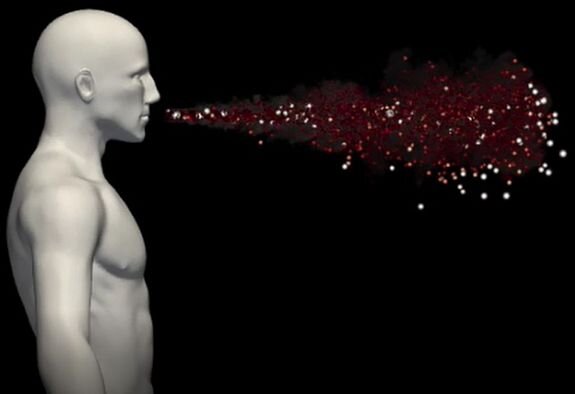
[ad_1]

Computer simulations show how long small droplets can stay suspended in the air. Credit: Vienna University of Technology
It is easier to get infected in winter than in summer, this is true for the Corona pandemic, influenza and other viral illnesses. Relative humidity plays an important role in this regard. Outdoors, it is much higher outdoors in winter than in summer, as evidenced by the fact that our breath condenses into droplets in cold air.
Previous models assumed that only large droplets pose a relevant risk of infection, because small droplets evaporate quickly. At TU Wien (Vienna), however, in cooperation with the University of Padua, it has now been shown that this is not true: due to the high humidity of the air we breathe, even small droplets can stay in the air much longer than previously assumed. The study was published in the scientific journal PNAS.
Simulations and plastic heads
Prof. Alfredo Soldati and his team at the TU Wien Institute for Fluid Mechanics and Heat Transfer are studying flows composed of different components, called “multiphase flows”. This includes the air that an infected person exhales when they sneeze: infectious viruses are found in liquid droplets of different sizes, with gas in between.
This mixing leads to a relatively complicated flow behavior: the droplets and the gas move, the two components influence each other, and the droplets can evaporate and become gas themselves. To get to the bottom of these effects, computer simulations have been developed, in which the dispersion of droplets and breathable air can be calculated at different environmental parameters, for example at different temperatures and humidity.
In addition, experiments were carried out.A nozzle with an electromagnetically operated valve was installed in a plastic head to spray a mixture of droplets and gas in a precisely defined manner. The process was recorded with high speed cameras, so it was possible to measure exactly which droplets remained in the air and for how long. The team of Francesco Picano from the University of Padua also participated in the research project.
Moist breathable air makes droplets soar longer
“We have found that the small droplets stay in the air an order of magnitude longer than previously thought,” explains Alfredo Soldati. “There is a simple reason for this: the droplet evaporation rate is not determined by the average relative humidity of the environment, but by the local humidity directly at the location of the droplet.” The exhaled air is much more humid than the ambient air, and this exhaled humidity causes the small droplets to evaporate more slowly. When the first droplets evaporate, this locally leads to higher humidity, which further slows down the process of evaporation of the other droplets.
“This means that the small droplets are infectious longer than expected, but that shouldn’t be a reason to be pessimistic,” says Alfredo Soldati. “It just shows us that you have to study these phenomena in the right way to understand them. Only then can we make scientifically sound recommendations, for example regarding masks and safety distances.”
COVID-19: Distancing and masks are not enough
Jietuo Wang et al, Short-term exposure to airborne virus transmission and current guidelines, Proceedings of the National Academy of Sciences (2021). DOI: 10.1073 / pnas.2105279118
Provided by Vienna University of Technology
Quote: Droplets with coronaviruses last longer than thought (2021, September 17) retrieved September 18, 2021 from https://medicalxpress.com/news/2021-09-droplets-coronaviruses-longer-previously -thought.html
This document is subject to copyright. Other than fair use for private study or research purposes, no part may be reproduced without written permission. The content is provided for information only.
[ad_2]
Source link